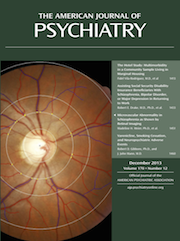Emergency Department Recognition of Mental Disorders and Short-Term Outcome of Deliberate Self-Harm
Abstract
Objective
The authors sought to characterize the short-term risks of repeat self-harm and psychiatric hospital admission for deliberate self-harm patients discharged from emergency departments to the community, focusing on recognition of mental disorders in the emergency department.
Method
A retrospective longitudinal cohort analysis of national Medicaid claims data was conducted of adults 21–64 years of age with deliberate self-harm who were discharged from emergency departments (N=5,567). Rates and adjusted risk ratios are presented of repeat self-harm visits and inpatient psychiatric admission during the 30 days following the initial emergency visit.
Results
Approximately 9.7% of self-harm visits were followed by repeat self-harm visits and 13.6% by inpatient psychiatric admissions within 30 days after the initial emergency visit. The rate of repeat self-harm visits was inversely related to recognition of a mental disorder in the emergency department (adjusted risk ratio [ARR]=0.66, 95% CI=0.55–0.79) and directly related to recent diagnosis of anxiety disorders (ARR=1.56, 95% CI=1.30–1.86) or personality disorders (ARR=1.67, 95% CI=1.19–2.34). Recognition of a mental disorder in the emergency department was inversely related to repeat self-harm among patients with no recent mental disorder diagnosis (ARR=0.57, 95% CI=0.41–0.79); any recent mental disorder diagnosis (ARR=0.70, 95%=0.57–0.87); and depressive (ARR=0.71, 95% CI=0.54–0.94), bipolar (ARR=0.70, 95% CI=0.51–0.94), and substance use (ARR=0.71, 95% CI=0.53–0.96) disorder diagnoses. Recognition of a mental disorder was also inversely related to subsequent inpatient psychiatric admission (ARR=0.81, 95% CI=0.71–0.93).
Conclusions
Adults who are discharged to the community after emergency visits for deliberate self-harm are at high short-term risk of repeat deliberate self-harm and hospital admission, although these risks may be attenuated by clinical recognition of a mental disorder in the emergency department.



